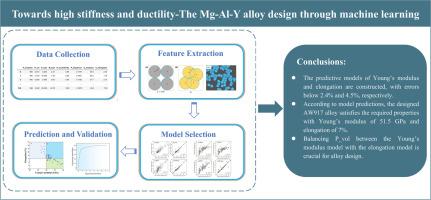实现高刚度和延展性--通过机器学习设计 Mg-Al-Y 合金
IF 11.2
1区 材料科学
Q1 MATERIALS SCIENCE, MULTIDISCIPLINARY
引用次数: 0
摘要
在传统的试错法中,提高镁合金的杨氏模量,同时保持良好的延展性一直是一个挑战。因此,需要探索更高效、更快捷的方法来设计具有高模量和高延展性的镁合金。本研究采用机器学习(ML)和辅助微结构控制方法来设计高模量镁合金。基于文献来源的丰富数据,该 ML 模型提取了影响刚度和延展性的六个关键特征。因此,通过 XGBoost 机器学习模型,建立了杨氏模量和伸长率的预测模型,误差分别小于 2.4% 和 4.5%。在给定的六个特征范围内,可以制造出杨氏模量超过 50 GPa、伸长率超过 6% 的镁合金。作为验证,实验制备的 Mg-Al-Y 合金达到了六个特征的标准,杨氏模量为 51.5 GPa,伸长率为 7%。此外,还引入了 SHapley Additive exPlanation(SHAP)来提高模型的可解释性。这表明,平衡强化剂的体积分数(这是最重要的特征)是通过两种模型获得高杨氏模量和良好伸长率的 Mg-Al-Y 合金的关键。加强钢筋分散、减小钢筋和晶粒尺寸可进一步提高高刚度镁合金的伸长率。本文章由计算机程序翻译,如有差异,请以英文原文为准。

Towards high stiffness and ductility-The Mg-Al-Y alloy design through machine learning
In traditional trial-and-error method, enhancing the Young's modulus of magnesium alloys while maintaining a favorable ductility has consistently been a challenge. It is a need to explore more efficient and expedited methods to design magnesium alloys with high modulus and ductility. In this study, machine learning (ML) and assisted microstructure control methods are used to design high modulus magnesium alloys. Six key features that influence stiffness and ductility have been extracted in this ML model based on abundant data from literature sources. As a result, predictive models for Young's modulus and elongation are established, with errors less than 2.4% and 4.5% through XGBoost machine learning model, respectively. Within the given range of six features, the magnesium alloys can be fabricated with the Young's modulus exceeding 50 GPa and an elongation surpassing 6%. As a validation, Mg-Al-Y alloys were experimentally prepared to meet the criteria of six features, achieving Young's modulus of 51.5 GPa, and the elongation of 7%. Moreover, the SHapley Additive exPlanation (SHAP) is introduced to boost the model interpretability. This indicates that balancing the volume fraction of reinforcement, the most important feature, is key to achieve Mg-Al-Y alloys with high Young's modulus and favorable elongation through the two models. Enhancing reinforcement dispersion and reducing the size of reinforcement and grain can further improve the elongation of high-stiffness Mg alloy.
求助全文
通过发布文献求助,成功后即可免费获取论文全文。
去求助
来源期刊

Journal of Materials Science & Technology
工程技术-材料科学:综合
CiteScore
20.00
自引率
11.00%
发文量
995
审稿时长
13 days
期刊介绍:
Journal of Materials Science & Technology strives to promote global collaboration in the field of materials science and technology. It primarily publishes original research papers, invited review articles, letters, research notes, and summaries of scientific achievements. The journal covers a wide range of materials science and technology topics, including metallic materials, inorganic nonmetallic materials, and composite materials.
 求助内容:
求助内容: 应助结果提醒方式:
应助结果提醒方式:


